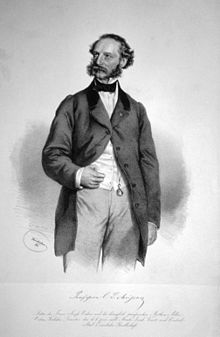Karl von Meißner

Karl Ludwig Meißner , since March 10, 1866 Karl Ludwig Ritter von Meißner (born June 7, 1809 in Kronstadt , † June 19, 1868 in Reichenau near Vienna ) was an Austrian - Braunschweig railway pioneer and professor of building sciences at the Collegium Carolinum in Braunschweig . As a knight of the Iron Crown Order, 3rd class, he was awarded the hereditary Austrian knighthood on March 10, 1866 in Vienna .
Life
Karl Meißner was the only son of the natural scientist and inventor Paul Traugott Meißner (1778–1864) and Sarah Elisabeth von Langendorf. After completing his technical and philosophical studies in Vienna , in 1828 - barely 19 years old - he went to his birthplace Kronstadt as an engineer . In 1830 he was transferred to the Imperial and Royal Building Department in Vienna. When in 1836 the permit for the construction of the first Austrian locomotive railway was granted, he was one of the first Austrian technicians to work on this construction. After a long journey through Belgium and England, he was appointed senior engineer adjunct and was partly in charge of the routing of the Vienna – Brno and Lundenburg – Prerau lines .
In 1841 Karl Ludwig Meißner followed a repeated call to him as professor of building sciences at the ducal Brunswick Collegium Carolinum and at the same time was appointed technical director of the state railways to be built Braunschweig - Aschersleben , Braunschweig - Lehrte and Wolfenbüttel - Harzburg , which railways according to his plans were under his special line were run; mountain locomotives were also successfully introduced under him for the first time on mountain railways with a 1/40 gradient.
In 1851 the Austrian Minister of Commerce, Karl Ludwig von Bruck, appointed the professor, who was still teaching in Braunschweig, to the “General Directorate for Communications” in Vienna. There he worked first as the imperial-royal ministerial commissioner 1st class and finally as technical inspector 1st class on the state railways Mürzzuschlag to Laibach and from Gänserndorf to Szolnok , as well as on the private railways from Vienna to Bruck and Gloggnitz - Oedenburg .
When the southern railway and its branch lines were transferred to the French company in 1859, Karl Meißner was first appointed general inspector, in 1860 traffic director and immediately managed the entire railway complex to Oedenburg, Villach , Szöny , Ofen , Sissek , Karlstadt and Trieste . Since 1830, with the exception of the decade from 1841–1851, which he spent in Braunschweig, he worked in Austria in the railway service and met several institutions there for the successful improvement of railway construction and operations.
Karl Meißner's merits in promoting and securing communication have been recognized several times. After he had previously been awarded the Knight's Cross of the Franz Joseph Order , he received the Knight's Cross from the Order of the Iron Crown in an imperial handwriting on January 3, 1865 and was elevated to the Austrian hereditary knighthood with a diploma of March 10, 1866 . In doing so, he became the founder of one of the noble Meißner families , which still exists today as the "Knights of Meißner".
In the winter of 1856/1857, Karl Ritter von Meißner was in charge of the routing of the - not executed - Arad- Kronstadt railway line and had an interesting correspondence from this period, which is of essential importance for the history of the battle between the Rothenthurm and Kronstadt lines .
The widower Karl Ritter von Meißner died as an inspector at the General Inspection for Austrian Railways after a long period of suffering and left three sons.
literature
- Constantin von Wurzbach : Meißner, Karl Ludwig Ritter von . In: Biographisches Lexikon des Kaiserthums Oesterreich . 17th part. Imperial and Royal Court and State Printing Office, Vienna 1867, p. 312 f. ( Digitized version ).
- Josef Trausch : Knight v. Meißner Karl Ludwig , in: Writer's Lexicon of the Transylvanian Germans , Volume 2. Kronstadt 1870. P. 406–408 ( digitized version )
- Eugen von Friedenfels : Meißner, Karl Ludwig Ritter von . In: Allgemeine Deutsche Biographie (ADB). Volume 21, Duncker & Humblot, Leipzig 1885, p. 245 f.
- Genealogisches Handbuch des Adels , Adelslexikon Volume VIII, Complete Series Volume 113. CA Starke Verlag , Limburg / Lahn 1997, ISBN 3-7980-0813-2 , pp. 404-405
| personal data | |
|---|---|
| SURNAME | Meissner, Karl von |
| ALTERNATIVE NAMES | Meißner, Karl Ludwig Ritter von (full name); Meissner, Karl; Meißner, Karl Ludwig (full name before ennoblement) |
| BRIEF DESCRIPTION | Austrian-Braunschweig railway pioneer and emeritus professor of building sciences at the Collegium Carolinum |
| DATE OF BIRTH | June 7, 1809 |
| PLACE OF BIRTH | Kronstadt |
| DATE OF DEATH | June 19, 1868 |
| Place of death | Reichenau |